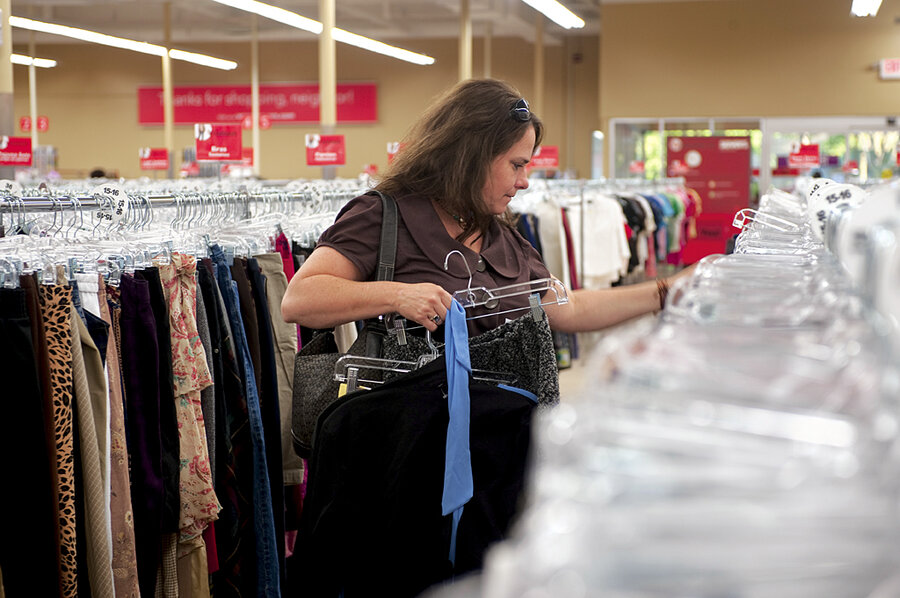A middle class thrift store: Only their retailer knows for sure
Loading...
| Framingham, Mass.
At Savers, the wide, tiled aisles, color-coded clothing racks, and prominent corporate marketing slogan – "Thanks for shopping, neighbor!" – imply discount retail: maybe a Marshalls or T.J.Maxx.
But the occasional wrinkled blouse or exquisitely preserved, frumpy jumper – and most of all the prices – scream something else: thrift store. The thrift store – a nonprofit charity tradition for raising money and catering to the needy or the frugal – has gone upscale with the Savers national chain of for-profit outlets.
"This kind of store will change the way people look at thrift stores," suggests Sharon McLean, a nurse and mother of three who frequents the Savers store in this suburban-Boston shopping area. "Image is everything. There are more upscale customers here because of that."
Aaron Rubio, a Savers employee stocking shelves on a recent weekday, agrees, noting that his work environment here is not the usual "dark and gloomy" he associates with thrift shops: "It's always bright and clean."
Defying the stereotype works for Savers. Here in Framingham, just down the street from Target and around a corner from a high-end regional mall, Savers definitely has a retail vibe that blends in. But while most of its retail neighbors are still waiting for the reported "end of the recession" to actually hit their own registers, the Savers chain seems to be growing by focusing on a new secondhand-shopping demographic – the penny-wise middle-class shopper.
A working mom can unearth a gold mine in the Savers racks: On a recent day she could find top-quality Ann Taylor slacks priced at $9.99 for herself; and for her teenage daughter, a pair of trendy $8.99 Hollister jeans. She has a pick of sturdy family-room TV consoles all between $9.99 and $14.99. Colorful ties – sans spots – go for $1.99 apiece and an L.L. Bean men's fleece jacket is a steal at $16.99.
Even as the economy tanked, starting with the stock market collapse in October 2008, Savers embarked on rapid expansion. It has opened 39 new outlets since January 2009. Now, with 250 stores in the United States, Canada, and Australia, Savers' total revenue for 2009 was $750 million – up 12 percent from 2008.
Based in Bellevue, Wash., Savers opened its first store in 1954 in San Francisco. The chain operates stores under three names – Savers, Value Village, and, in Quebec, Village des Valeurs. It buys merchandise – clothing, home goods, books, and accessories – from nonprofit partners who collect donations. All nine Savers stores in Massachusetts buy from the Epilepsy Foundation. The chain targets shoppers with an average household income between $40,000 and $70,000. But it's not just the lower middle class heading to upscale thrift stores, observes Delia Passi, CEO of WomenCertified, a Miami-based sales consultancy. "Take it up a notch: You have people you would consider affluent using thrift stores as a way to feed into their nouveau concept of what it means to be frugal."
She offers that, on Labor Day, she visited a Salvation Army store for the first time to help her daughter look for a wall unit. "At first I was very apprehensive about the quality of product and the people there," she says. "Well, was I surprised. I noticed cars in the parking lot [everything] from a Volkswagen to a Lexus. I saw the gamut."
Across the board, secondhand stores are prospering. Industry net sales grew 12.7 percent from 2008 to 2009, according to the National Association of Resale & Thrift Shops (NARTS). Nonprofit Goodwill, for example, saw retail sales increase 9 percent from June 2009 to June 2010. In contrast, the US Census reports that total retail sales in the same period decreased 7.3 percent.
During tough times, middle- and upper-class customers also frequent dollar and discount shops, says Britt Beemer, founder of America's Research Group. His research shows that in hard times as well as good times 16 percent of American consumers use thrift stores. New thrift-store customers don't plan to leave.
"Whether they have a job or not, 80 percent of American shoppers said that they will not go back to the way they were," Ms. Passi says. "Even if the economy turns around."






